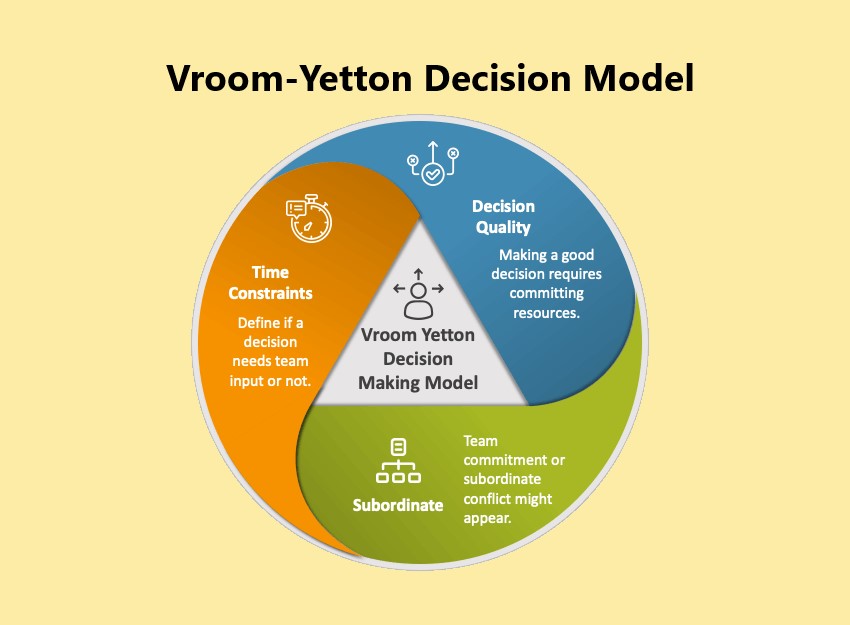 The Vroom-Yetton Decision Model offers leaders a practical approach to making effective decisions. Developed by Victor Vroom and Phillip Yetton, this model tailors decision-making to the specific needs of each situation. It helps you evaluate factors like time, complexity, and team involvement, guiding you toward the most appropriate style. Whether facing a quick decision or one needing team input, the model provides a clear framework for action.
The Vroom-Yetton Decision Model offers leaders a practical approach to making effective decisions. Developed by Victor Vroom and Phillip Yetton, this model tailors decision-making to the specific needs of each situation. It helps you evaluate factors like time, complexity, and team involvement, guiding you toward the most appropriate style. Whether facing a quick decision or one needing team input, the model provides a clear framework for action.
By using the Vroom-Yetton Decision Model, you can make choices that are both efficient and aligned with your team’s strengths. This approach supports better decision outcomes, improves team morale, and increases engagement. Leaders across various industries have applied this model successfully, demonstrating its value in diverse settings. With its structured guidance, this model can help you navigate decisions confidently and strengthen your leadership effectiveness.
Introduction to the Vroom-Yetton Decision Model
The Vroom-Yetton Decision Model helps leaders determine the most effective decision-making style for specific situations. This model recognizes that no single approach suits every situation. Instead, it offers a structured way to adapt leadership styles based on variables like the complexity of the decision, the knowledge of team members, and the need for team involvement.
At its core, the Vroom-Yetton Decision Model provides a decision tree that guides leaders through a set of questions about the situation. These questions help you assess factors like time constraints, the importance of team commitment, and the level of information available. Based on your answers, the model suggests one of several decision-making styles, ranging from autocratic to group-based approaches.
This model is particularly useful for balancing efficiency and engagement. It encourages you to consider both the outcome of a decision and the impact on team morale. Leaders who use this model can improve team participation and make decisions that are both effective and widely supported.
Understanding the Key Decision-Making Styles
The Vroom-Yetton Decision Model identifies three main decision-making styles: autocratic, consultative, and group-based. Each style serves a specific purpose and fits particular scenarios. The autocratic style involves a leader making decisions independently, without input from the team. This approach is useful when time is short, information is clear, and team buy-in is less critical.
The consultative style allows for some team involvement, where the leader seeks input before making a final decision. This method can be effective when you need more information or a broader perspective. It also helps increase team support for the decision, as members feel heard. However, the leader retains full authority over the final choice, making it both participatory and efficient.
Finally, the group-based style centers on team collaboration, with the group collectively discussing and deciding on an action. This approach works well when decisions impact the whole team and commitment is essential. Although it can be time-consuming, it fosters high team engagement and ownership. The Vroom-Yetton Decision Model helps you select the best approach for each situation, balancing efficiency with team involvement.
Factors Influencing Decision-Making: Analyzing Situational Variables
The Vroom-Yetton Decision Model emphasizes analyzing situational variables to guide decision-making. These factors help determine which decision-making style best suits the situation. One key variable is problem complexity. If a problem is straightforward, a direct, autocratic decision-making style may be effective. However, complex issues often require broader input, especially when several perspectives could clarify the best approach.
Team expertise also plays an important role. When team members have specialized knowledge or experience relevant to the decision, their input can be invaluable. In these cases, a consultative or group-based approach can yield better results by leveraging the team’s insights. However, if expertise is limited or the leader has all necessary information, an autocratic decision may be more efficient.
Time constraints are another essential factor. When decisions must be made quickly, a group-based approach may be impractical. Autocratic or consultative styles allow for faster action, which can be critical in high-stakes or time-sensitive situations. By weighing these factors—complexity, expertise, and timing—the Vroom-Yetton Decision Model helps you select a decision-making style that balances effectiveness with efficiency. This approach supports decisions that fit the context, optimizing outcomes and maintaining team morale.
The Decision Tree Framework: Steps to Effective Decision-Making
The decision tree in the Vroom-Yetton Decision Model offers a structured approach to choosing the best decision-making style. It guides you through a series of questions about the situation, helping you clarify the best approach for each scenario. Each question addresses different aspects, like problem importance, team expertise, and the need for team commitment, steering you toward the most suitable style.
To use the decision tree, start by defining the importance of the decision. If team commitment is essential, a collaborative approach might work best. On the other hand, if urgency is high and input isn’t required, the tree may lead you toward an autocratic decision style. Each response to these questions narrows down the choices, gradually directing you to a recommendation aligned with the situation’s needs.
The decision tree framework simplifies complex decisions, making it easier to balance efficiency with team involvement. It not only guides you toward a logical choice but also helps improve team satisfaction by using the appropriate decision-making style. By following the Vroom-Yetton Decision Model’s decision tree, you can make clear, well-supported decisions that match the demands of different situations. This structured approach saves time and ensures that the decision process respects both the context and the team’s role.
Benefits of Applying the Vroom-Yetton Model in Leadership
Applying the Vroom-Yetton Decision Model in leadership offers several advantages. It helps you make decisions that fit the context, leading to better outcomes. By analyzing factors like team expertise, time constraints, and commitment, this model ensures that each decision is carefully tailored to the situation. This approach reduces the risk of rushed or unsuitable choices.
Another significant benefit of this model is improved team engagement. When team input is valued in consultative or group-based decisions, members feel their contributions matter. This sense of involvement increases commitment to the decision, as team members are more likely to support outcomes they helped shape. Additionally, the model’s emphasis on situational factors shows respect for the team’s strengths, building trust in your leadership.
Using the Vroom-Yetton Decision Model also boosts morale by aligning the decision-making style with team needs. When decisions are appropriate for the context, teams feel less frustration, as processes seem logical and fair. This clarity strengthens team cohesion and motivates members, fostering a positive environment. By integrating the Vroom-Yetton Decision Model into your leadership approach, you can create a structured, respectful decision-making culture that supports both effective outcomes and a motivated team.
Real-World Applications and Examples of the Vroom-Yetton Model
The Vroom-Yetton Decision Model has proven valuable in diverse industries, providing leaders with practical strategies for decision-making. For example, in healthcare, where decisions often involve complex variables and high stakes, managers have used the model to determine the level of team involvement in clinical decisions. By assessing each situation through the model, they’ve been able to make swift choices for routine procedures while consulting the team for more intricate, patient-specific cases. This approach has improved efficiency and strengthened trust among healthcare staff.
In manufacturing, plant managers frequently face time-sensitive decisions regarding production issues. By applying the Vroom-Yetton Decision Model, they can gauge whether to make an independent call or consult their teams. In one case, a production supervisor faced a machinery breakdown that required urgent action. The model guided him to make an autocratic decision to minimize downtime. In contrast, for process changes affecting multiple departments, the model recommended a consultative approach. This flexibility helped the manager achieve timely, balanced decisions, improving workflow and morale.
Tech companies have also benefited from the Vroom-Yetton Decision Model, especially in fast-paced development environments. Project managers, needing to decide on project directions, have used the model to involve their teams when problem-solving and innovation are required. This team-driven approach has led to creative solutions, as it leverages the team’s expertise. The model’s structured guidance allows leaders across industries to make decisions that align with specific scenarios, balancing speed with engagement and fostering a culture of effective collaboration.
Conclusion
The Vroom-Yetton Decision Model provides a structured approach to making effective decisions across a variety of scenarios. By helping you assess situational factors like time constraints, team expertise, and decision complexity, this model guides you toward the most fitting decision-making style. Leaders who use this model benefit from balanced, well-informed choices that align with their team’s needs.
Applying the Vroom-Yetton Decision Model can enhance team engagement, improve morale, and lead to better overall outcomes. The model’s flexibility allows you to adapt your approach to each situation, promoting both efficiency and inclusivity. In fast-paced or high-stakes environments, the ability to quickly select an effective decision-making strategy is invaluable. With this model, you can build a decision-making process that supports team trust and drives consistent results.


